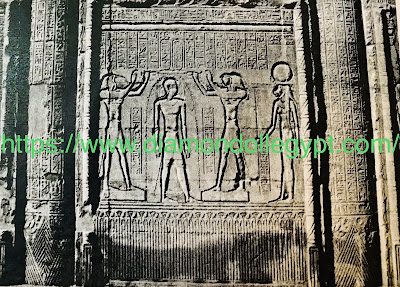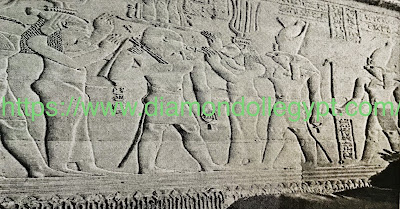The first wall boards
Why is the god of recordings named so ?
Why not be a male lion ?
Because the ancient Egyptians also understood that the female lions possessed better hunting ability than male lions , it was more appropriate to use female lions to represent power.
There is an another old saying that "Sekhment is the daughter of Ra , the sun god" Then she turned to the flame in the eyes of Ra , in order to allow her to punish those humans who did not respect Ra , she brutally killed the humans , she enjoyed this killing so much , as she was red-eyed , and humans were nearly on the verge of extinction , Ra knew she was wrong . In order to stop her , Ra mixed wine with red pomegranate juice to turn it into a blood like liquid and gave it to Sekhmet , which she could not stand after drinking . Ra seized this opportunity to get rid of her "brutality" and "her hatred", replacing them into "care"and "kindness".
There are two of the eagle god Horus stand behind the lioness God , where in many temples in Egypt there are carved wall panels of the eagle god , covering his various ages from birth to adulthood , the most famous of which are : the eagle god in childhood and the eagle god in adulthood.
The gods surrounded the king , and each god extended one hand to the king , just like the ancient Chinese martial arts masters who imparted skills , the gods transferred their divine powers to the king . Which indicates that all gods supported him throughout his reign.
This scene is called the scene of purification. where the sacred is poured out on the King’s head in order to purify himself. Purity is indispensable for the ruling king (The Pharaoh).
The king is pure and his (KA) is pure in the temple and the tomb. Purity is life . The king is purified with the purity of the pure God. This qualifies him to be sacred . Purity gives him the right to sit on the throne and see the ancestors who are purified upon meeting him . Purity is the expulsion of the powers of impurity and chaos from the body of the king and the temple, it means getting rid of the state of impurity where the sky is pure for Ra. Purity is an act of the cosmic system. The king’s purity includes him from the four directions of the world. The king purifies himself with the eye of Horus as a liquid water offering that gives him a state of purify.
Here we see the gods pouring the king’s sacred water cans in the form of signs of life (Ankh), meaning they give him purity for thousands of years.
The next thing that we see is the king’s honor of Goddess, at that time, the ancient Egyptian actually understood the principle “if there is a gain, there must be a loss” and if you want your dream to come true, you must pay in return.
All the foods grown on the land of Egypt, the animals that were raised, and the items made in honor of the gods can be offered, but the types of offerings offered are closely related to your special requirements.
For example, if you want to bless the gods, you have to give the god the amulets ; if you want the Nile to overflow, you have to give the deity milk and wine. We can see a variety of offerings here, including figs, geese, perfume vessels, etc.
After we saw this mural, the king existed from the palace, and in front of him were many people carrying high-flag poles to help him clear the way, so as to ensure that the road for the king to travel unimpeded and provide comprehensive protection for the king’s safety.
The mural we see below looks familiar, everyone should know what they’re doing, right? Yes, the mural depicts that before the king enters this temple, the gods perform a cleansing ceremony for the king, the gods spread the scepter and the key to life around the king’s body, representing the supreme power and eternal life of the king.
We are still moving forward, this mural depicts the coronation ceremonies of the king, wearing different crowns and she represents Upper and Lower Egypt respectively, indicating that both Upper and Lower Egypt are both crowning him as king and which also indicates their conviction in this king.
The mural, we see now, on the far right is too important, he is the eagle god Horus.
Horus has three branches of date palm, each branch of date palm represents one year, and three branches represent three years; there is a frog squatting under the branch, and one frog represents the number one hundred thousand.
Thus, the date palm branch and the frog together, which means 300 thousand years, indicating that : King Ptolemy VIII is next that door, and the two women who stand behind him are very famous. Now I will tell you what is going on between them.
In order to preserve the nobility of Manchu origin, ancient Chinese royal families married close relatives. Brothers, father and son often killed each other in order to fight for power, and kings in the Ptolemaic period did the same.
Cruelly, without emotion, seeking only practical benefits.
It is said that Ptolemy V fathered three children during his reign in Egypt.
The eldest son of Ptolemy VI, the eldest daughter Cleopatra II and the second son Ptolemy VIII, and after the death of the old king Ptolemy V, the brothers Ptolemy VI and VIII quarrelled over who would be in power , and suddenly one day Ptolemy VI died in battle. Younger brother Ptolemy VIII was already on the throne, his elder brother Ptolemy VI married his sister Cleopatra II as a relative and they had a son and daughter, ( his son Ptolemy VII and daughter Cleopatra III ). When Ptolemy VI died in battle, the throne was transferred to his son Ptolemy VII, the nephew of Ptolemy VIII, and Ptolemy VIII was very angry. The person who stopped me died he killed his nephew, rather, he monopolized all their rights to himself, as he married his brother’s widow, that is, his sister Cleopatra II and his niece, that is, the daughter of his sister Cleopatra III, are in his fist “ under his power “.
So we see two women standing behind the king in this mural, one in front is Cleopatra II, and behind her is Cleopatra III. Although the god grant king Ptolemy VIII good wishes for 300,000 years, he actually ruled Egypt for 54 years.
The ancient Egyptians also made notable achievements in astronomy, as the solar calendar that they created was the oldest calendar in human history, and since 4000 BC, the Egyptians had established a year of 365 days.
During the Old Kingdom, the Egyptians noticed that when the Nile River began to flood, Sirius would rise from the horizon with the sun, and this day was designated as the first day of the new year.
The ancient Egyptians also divided the year into three seasons: floods, sowing and harvesting according to the fluctuations of the Nile River and the laws of crop growth. Each season has 4 months, a total of 12 months, and each month has 3 seasons. A week, every week has 10 days, so the number of days is 360 days , so where are the other five days ?
They calculate the remaining five days at the end of each year, consisting it as a public holiday, so there are 365 days in the whole year. Unfortunately, this type of calendar is 6 hours shorter than the current solar calendar, which means that there will be an error for one day every 4 years, one month difference will be found every 120 years.
With the help of the Egyptian astronomer Sosichenni, the Roman leader Gaio Julio Caesar conducted a comprehensive review of the solar calendar, stating that the year is divided into 12 months, with 31 days for the odd months and 30 days for the even months. Therefore, there are 366 days a year, and the execution of death row prisoners in the Roman Empire is often arranged in February.
The Ancient Egyptians thought that “February is a sinister month”, so they require that every day of the week be subtracted from February with one day, that is, there are only 29 days in February in every normal year, so that the count is up to 365 days a year.
Scientists later discovered through research that the time the earth revolves around the sun is approximately 365.25 days. The calendar we use right now contains 365 days a year, which means that approximately one day is added to the calendar every four years.
To understand the rest, an additional day will be added every 4 years in February, that is February 29. This day is called “leap year” and this year is called “ leap year”. In short, the Roman period used a calendar very close to the current Gregorian calendar.
The mural we are looking at now is the oldest calendar in human history, you know that the Chinese and Japanese oracle bone engravings are a point drawn in the middle of a circle.
As for writing the word (day) in hieroglyphs in ancient Egypt, it is written in the form of a solar disk. Ten is represented by a horseshoe, so we look at the hieroglyphs in the upper grid. The solar disk on the far right is represented by the word (day).
The two horseshoes in the middle represent the number twenty, the other to the far left in hieroglyphs is the number 2, together they form the number 22, etc. Here are the numbers 23,24, and up to 29.
The hieroglyphs in the grid are called below the number 29. In ancient Egyptian, which means the end, which means that the month has ended on the twenty-ninth, and there is no 30.
Everyone, follow me and see, this is the secret passage, this underground passage leads outside the temple, and there is a special board at the top of the secret passage, only the high priest can distinguish the secret passage from a lot of floor tiles. Slate. According to archaeologists, these secret passages could be used by temple priests to escape in emergencies.
Come on and keep approaching this image, this position was difficult with me. The ancient Egyptians believed that position is the ideal position for childbirth.
Modern medical scientists have discovered that the squatting position is actually one of the most suitable positions for childbirth. Additionally, the ancient Egyptians had many wonderful ways to test the reproductive functions of women.
For example, they mixed watermelon with breast milk for a woman to drink, and if she vomited, she could be pregnant, but if she did not vomit, she drank and her stomach became swollen. Swelling when drinking indicates that she has genetic inherited problems and cannot get pregnant.
There is also a test determining the kind of the fetus if it is a boy or a girl by preparing two small bowls, one of which contains wheat and the other contains barley, then the urine of pregnant women spills into these two vessels.
If the wheat sprouts quickly, this means that it will give birth to a girl, and on the contrary, if the barley grows quickly, then this means that the women will give birth to a boy, you can try this method if you are interested.


Great new facts about ancient Egypt.
ReplyDeleteKeep the hard work Mira 💪